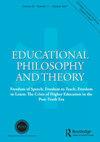John Cage and the aesthetic pedagogy of chance & silence
IF 1.8
4区 教育学
Q2 EDUCATION & EDUCATIONAL RESEARCH
引用次数: 0
Abstract
The composer, author, and teacher, John Cage, was exercised by our ‘inability’ to truly listen when approaching sound. In exploring the influences on Cage’s avant-garde style, specifically the spiritual discipline found in both Zen Buddhism and Chance operations, this paper attempts to distinguish his philosophy (and use) of silence and chance as an aesthetic pedagogy. In accordance with Dewey’s aesthetic theory and Shusterman’s Somaesthetics, resolving the inability to listen is aesthetically conceived as somatic ‘attuning’ to the occurrence of chance sounds in the ambience of the world. By maintaining Cage’s spiritually informed approach as a compositional framework, this paper highlights how his philosophy of silence is pedagogically illustrative of the active engagement we can have with the world. This approach is most apparent in Cage’s 4’33”, where the ‘musicalizing’ of everyday sounds erodes the boundaries between art and life, creating a continuity with the world. Somewhat problematically, Cage attempted to make this possible by channelling experience into a state of immersion, unifying art and life by ‘letting go’ of subjectivity. But as is shown by the Fluxus artists who were inspired by Cage’s teachings, the possibility for negotiating Cage’s terms brings with it an opportunity to theoretically reflect on the educational processes that underpin Cage’s approach to sound.约翰·凯奇与机会美学教育学沉默
作曲家、作家兼教师约翰·凯奇(John Cage)对我们在接近声音时“无法”真正倾听感到非常苦恼。在探讨凯奇的前卫风格的影响,特别是禅宗和机会操作中发现的精神纪律,本文试图区分他的哲学(和使用)沉默和机会作为一种审美教育学。根据杜威的美学理论和舒斯特曼的身体美学,解决无法倾听的问题在美学上被认为是身体对世界环境中偶然声音的“调谐”。通过将凯奇的精神知识方法作为一个作曲框架,本文强调了他的沉默哲学如何在教学上说明我们可以与世界积极接触。这种方法在凯奇的《4分33秒》中表现得最为明显,日常声音的“音乐化”侵蚀了艺术与生活之间的界限,创造了与世界的连续性。有点问题的是,凯奇试图通过将体验引导到沉浸状态,通过“放弃”主观性来统一艺术和生活,从而使这成为可能。但正如激浪派艺术家们受到凯奇教导的启发所表明的那样,就凯奇的条件进行谈判的可能性带来了一个从理论上反思凯奇的声音方法的教育过程的机会。
本文章由计算机程序翻译,如有差异,请以英文原文为准。
求助全文
约1分钟内获得全文
求助全文
来源期刊

Educational Philosophy and Theory
EDUCATION & EDUCATIONAL RESEARCH-
CiteScore
4.20
自引率
15.00%
发文量
171
期刊介绍:
Educational Philosophy and Theory publishes articles concerned with all aspects of educational philosophy. It will also consider manuscripts from other areas of pure or applied educational research. In this latter category the journal has published manuscripts concerned with curriculum theory, educational administration, the politics of education, educational history, educational policy, and higher education. As part of the journal''s commitment to extending the dialogues of educational philosophy to the profession and education''s several disciplines, it encourages the submission of manuscripts from collateral areas of study in education, the arts, and sciences, as well as from professional educators. Nevertheless, manuscripts must be germane to the ongoing conversations and dialogues of educational philosophy.
 求助内容:
求助内容: 应助结果提醒方式:
应助结果提醒方式:


